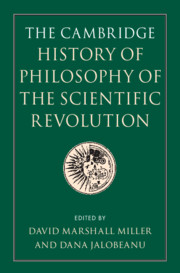Book contents
- The Cambridge History of Philosophy of the Scientific Revolution
- The Cambridge History of Philosophy of the Scientific Revolution
- Copyright page
- Contents
- Tables and Figures
- Contributors
- Preface
- Introduction The Disciplinary Revolutions of Early Modern Philosophy and Science
- Part I The Disciplines
- 1 The Uses of Ancient Philosophy
- 2 Novatores
- 3 Renaissance Aristotelianism(s)
- 4 What To Do With the Mechanical Philosophy?
- 5 The Later Sects: Cartesians, Gassendists, Leibnizians, and Newtonians
- 6 Confessionalization and Natural Philosophy
- 7 The Rise of a Public Science? Women and Natural Philosophy in the Early Modern Period
- Part II Disciplinary Activities
- Part III Problems and Controversies
- Bibliography
- Index
4 - What To Do With the Mechanical Philosophy?
from Part I - The Disciplines
Published online by Cambridge University Press: 14 January 2022
- The Cambridge History of Philosophy of the Scientific Revolution
- The Cambridge History of Philosophy of the Scientific Revolution
- Copyright page
- Contents
- Tables and Figures
- Contributors
- Preface
- Introduction The Disciplinary Revolutions of Early Modern Philosophy and Science
- Part I The Disciplines
- 1 The Uses of Ancient Philosophy
- 2 Novatores
- 3 Renaissance Aristotelianism(s)
- 4 What To Do With the Mechanical Philosophy?
- 5 The Later Sects: Cartesians, Gassendists, Leibnizians, and Newtonians
- 6 Confessionalization and Natural Philosophy
- 7 The Rise of a Public Science? Women and Natural Philosophy in the Early Modern Period
- Part II Disciplinary Activities
- Part III Problems and Controversies
- Bibliography
- Index
Summary
In the last thirty years, both the belief that the mechanical philosophy is an adequate historical category and the conviction that it made a positive contribution to the sciences were deconstructed. Hence the question addressed in this chapter: What to do with the mechanical philosophy? The chapter begins with a terminological enquiry about ‘mechanical philosophy’ as an emic category, and compares the use of the term on the Continent and across the Channel. It is then suggested that we examine controversies in which mechanical philosophers, having defined themselves in opposition to other natural philosophers, made explicit their expectations with regard to physical explanations. Three such controversies are discussed: one about the motion of the heart (Descartes versus Plempius); one about the elasticity of the air (Boyle versus More); and one about the universal attraction of bodies (Huygens and Leibniz versus Newton). Finally, to counter negative evaluations of the mechanical philosophy, the chapter points out the cognitive advantages of structural explanations, to which the mechanical explanations belonged.
Keywords
- Type
- Chapter
- Information
- Publisher: Cambridge University PressPrint publication year: 2022

